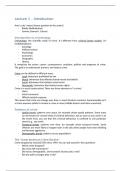College aantekeningen
Uitwerking Hoorcolleges Criminology & Safety
- Instelling
- Universiteit Utrecht (UU)
In dit document vind je alle 6 uitgewerkte hoorcolleges van het vak Criminology & Safety van de master Sociology: Contemporary Social Problems.
[Meer zien]




